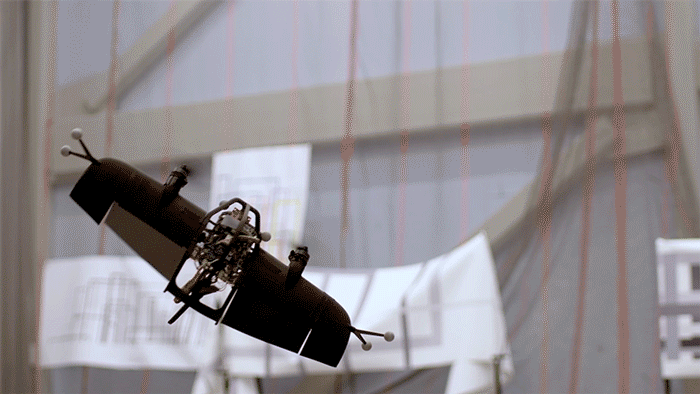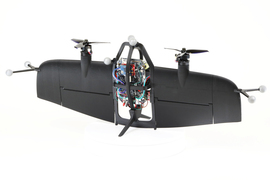A tailsitter is a fixed-wing aircraft that takes off and lands vertically (it sits on its tail on the landing pad), and then tilts horizontally for forward flight. Faster and more efficient than quadcopter drones, these versatile aircraft can fly over a large area like an airplane but also hover like a helicopter, making them well-suited for tasks like search-and-rescue or parcel delivery.
MIT researchers have developed new algorithms for trajectory planning and control of a tailsitter that take advantage of the maneuverability and versatility of this type of aircraft. Their algorithms can execute challenging maneuvers, like sideways or upside-down flight, and are so computationally efficient that they can plan complex trajectories in real-time.
Typically, other methods either simplify the system dynamics in their trajectory planning algorithm or use two different models, one for helicopter mode and one for airplane mode. Neither approach can plan and execute trajectories that are as aggressive as those demonstrated by the MIT team.
“We wanted to really exploit all the power the system has. These aircraft, even if they are very small, are quite powerful and capable of exciting acrobatic maneuvers. With our approach, using one model, we can cover the entire flight envelope — all the conditions in which the vehicle can fly,” says Ezra Tal, a research scientist in the Laboratory for Information and Decision Systems (LIDS) and lead author of a new paper describing the work.
Tal and his collaborators used their trajectory generation and control algorithms to demonstrate tailsitters that perform complex maneuvers like loops, rolls, and climbing turns, and they even showcased a drone race where three tailsitters sped through aerial gates and performed several synchronized, acrobatic maneuvers.

Courtesy of the researchers
These algorithms could potentially enable tailsitters to autonomously perform complex moves in dynamic environments, such as flying into a collapsed building and avoiding obstacles while on a rapid search for survivors.
Joining Tal on the paper are Gilhyun Ryou, a graduate student in the Department of Electrical Engineering and Computer Science (EECS); and senior author Sertac Karaman, associate professor of aeronautics and astronautics and director of LIDS. The research appears in IEEE Transactions on Robotics.
Tackling tailsitter trajectories
The design for a tailsitter was invented by Nikolai Tesla in 1928, but no one tried to seriously build one until nearly 20 years after his patent was filed. Even today, due to the complexity of tailsitter motion, research and commercial applications have tended to focus on aircraft that are easier to control, like quadcopter drones.
Trajectory generation and control algorithms that do exist for tailsitters mostly focus on calm trajectories and slow transitions, rather than the rapid and acrobatic maneuvers these aircraft are capable of making.
With such challenging flight conditions, Tal and his collaborators knew they would need to design trajectory planning and control algorithms specifically for agile trajectories with fast-changing accelerations in order to enable these unique aircraft to reach peak performance.
To do that, they used a global dynamics model, meaning one that applies to all flight conditions, ranging from vertical take-off to forward, or even sideways, flight. Next, they leveraged a technical property known as differential flatness to ensure that model would perform efficiently.
In trajectory generation, a key step is to ensure the aircraft can actually fly the planned trajectory — maybe it has a minimum turning radius that makes a particularly sharp corner infeasible. Since tailsitters are complex systems, with flaps and rotors, and exhibit such complicated aerial motions, it typically takes numerous calculations to determine if a trajectory is feasible, which hampers traditional planning algorithms.
By employing differential flatness, the MIT researchers can use a mathematical function to quickly check whether a trajectory is feasible. Their approach avoids many of the complicated system dynamics and plans a trajectory for the tailsitter as a mathematical curve through space. The algorithm then uses differential flatness to rapidly check the feasibility of that trajectory.
“That check is computationally very cheap, so that is why with our algorithm, you can actually plan trajectories in real-time,” Tal explains.
These trajectories can be very complex, rapidly transitioning between vertical and horizontal flight while incorporating sideways and inverted maneuvers, because the researchers designed their algorithm in such a way that it uniformly considers all of these diverse flight conditions.
“Many research teams focused on the quadcopter aircraft, which is very common configuration for almost all consumer drones. The tailsitters, on the other hand, are a lot more efficient in forward flight. I think they were not used as much because they are much harder to pilot,” Karaman says. “But, the kind of autonomy technology we developed suddenly makes them available in many applications, from consumer technology to large-scale industrial inspections.”
A tailsitter airshow
They put their method to the test by planning and executing a number of challenging trajectories for tailsitters in MIT’s indoor flight space. In one test, they demonstrate a tailsitter executing a climbing turn where the aircraft turns to the left and then rapidly accelerates and banks back to the right.
They also showcased a tailsitter “airshow” in which three synchronized tailsitters performed loops, sharp turns, and flew seamlessly through airborne gates. These maneuvers wouldn’t be possible to plan in real-time without their model’s use of differential flatness, says Tal.
“Differential flatness was developed and applied to generate smooth trajectories for basic mechanical systems, such as a motorized pendulum. Now, more than 30 years later, we’ve applied it to fixed-wing aircraft. There might be many other applications we could apply this to in the future,” Ryou adds.
The next step for the MIT researchers is to extend their algorithm so it could be used effectively for fully autonomous outdoor flight, where winds and other environmental conditions can drastically affect the dynamics of a fixed-wing aircraft.
“The authors derived a compelling result concerning the differential flatness property for the newly introduced VTOL tailsitter, accounting for the complete system dynamics. This achievement carries numerous advantages in terms of dynamic feasibility and computational efficiency throughout trajectory generation and tracking,” says Giuseppe Loianno, assistant professor of electrical and computer engineering at New York University, who was not involved with this work. “This approach enables impressive agile flight maneuvers across a spectrum of demanding flight conditions in real-time, encompassing stall regimes, sideways uncoordinated flight, and even inverted flight. The versatility of the proposed approach holds promise in broadening the applicability of these platforms to various additional scenarios, including search and rescue, monitoring, and inspection presenting a compelling alternative to traditional VTOL platforms.”
This work was supported, in part, by the U.S. Army Research Office.













